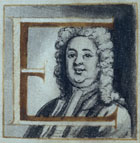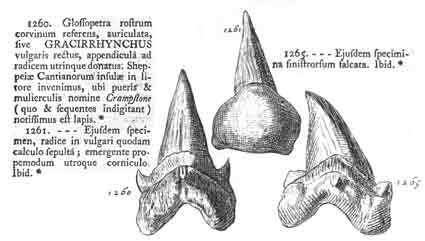 |
THE LITHOPHYLACII BRITANNICI ICHNOGRAPHIA of 1699AD
|
|
|
Edward Lhwyd (1660-1709) (Courtesy Ashmolean Museum) |
||
 |
 |
|
| Description of a Sheppey Hexanthid tooth. The numbering relates to the illustration numbering system | ||
 |
||
| More descriptions of Sheppey teeth. All of them are specimens of Otodus obliquus, and survive in very good condition in the collection of the Oxford Natural History Museum. | ||
|
Text
is in Latin
|
||
|
A
PAGE FROM LUIDII DOCUMENT OF 1699
|
||
|
Edward Lluyd called the Carcharodons "crampstones", and in a letter dated 28 March, 1695 (Gunther 1945, p. 269) wished that someone might persuade the copras-hunters of the Isle of Sheppey to collect all they found. Perhaps in the seventeenth century a cure for cramp was more popular in England, a poison-detector in Italy. excerpt from 'A Museum of the Early seventeenth Century' By Cyril Edward Nowill Bromhead, BA, FGS, FRGS. (Read 18Th. June, 1947) |
||
| Early Science in Oxford by R. T. Gunther vol XIV | ||
|
Life and Letters of Edward Lhwyd (second Keeper of the MUSEUM ASHMOLEANUM) Oxford March28. 1695 Dear Sr I have almost every week since my last expected Mr Woodwards book;' and therfore have thus long neglected writing to you, as having litle of moment to trouble you with. If you have perused it, I humbly beg your thoughts of it; and what character it bears in the world. It has acquire'd a great name in this town, partly because he undertakes to confirm by his observations the History of Moses, and partly because he buylds upon experiments; and tels us some things as his own, which doe not occurre in English books, or others of common request, and reading here. However when we come to consider him with some attention, we shall find him to differ from Moses litle lesse than ye author of ye, ,Sacred Theory. For wheras Moses tels us ye waters were increasing on the earth 150 days, before ye Fountains of the Deep were shut up: Mr Woodward informs us (p274-275) that the earth was not onely wholy drown'd in ye space of one fortnight, but that it was also totally dissolv'd. It's true these are not his ~ words, but they'l bear this sense. For when he tels us those antediluvian plants he finds in ye bowels of the earth; do plainly shew the Deluge happen'd, in the month of May; twill follow ye earth dissolv'd in that month, otherwise (according to his own hypothesis) these plants could not be bedded so deep in stone. And we can allow but a fortnight's time for it, because Moses says 'twas on ye 17 day of ye month, yt the Fountains of the Deep were opened. Thus we find his bypo- thesis agrees not with ye Scripture; but when we consider how far it may agree with reason and common sense; we find so many absurdities in it, that to me it seems scarce worth our consideration. 'Tis much to me that neither Dr Plucknet, Dr Robinson, nor all ye ingenious gentlemen he dayly converses with have been able to prevail with him to forbear troubling ye world with such whimsies. However I hope his book will have two good effects. 1st. That these enquiries after Form'd Stones, &c. will not hence forward be thought so trivial, as not to deserve the attention of the best philosophers; and that the invalidity of this Hypothesis, as well as of that of Dr Burnet; will make men preferre Natural History, to these romantic theories, which serve to no other use, but to give us some shew of ingenuity in ye inventors; who are yet in my opinion to be lesse valued than the authors of ingenious romances, for whereas those deliver their writeings as fables; these doe not onely fully belive what they write themselves, but endeavour to possesse others with the same perswasions, and have indeed too often succeeded therein in all ages. I am (Hond Sr) Yr most affectionat and obliged servant EDW. LHWYD If you could setle a correspondent in the Isle of Shepey to save us all the Crampstones the copras-women pick up for a month or two, I would now fall about a Lithologia Britannica: and so contrive it that the first tome shall consist of onely teeth and bones of fish. J. WOODWARD, An Essay toward a Natural History of the Earth. London, May, 1695. |
||
|
My thanks to Philip Powell of the Oxford Natural History Museum for his kind help compiling this page. For more information about this very early collector follow the link below. |
||



